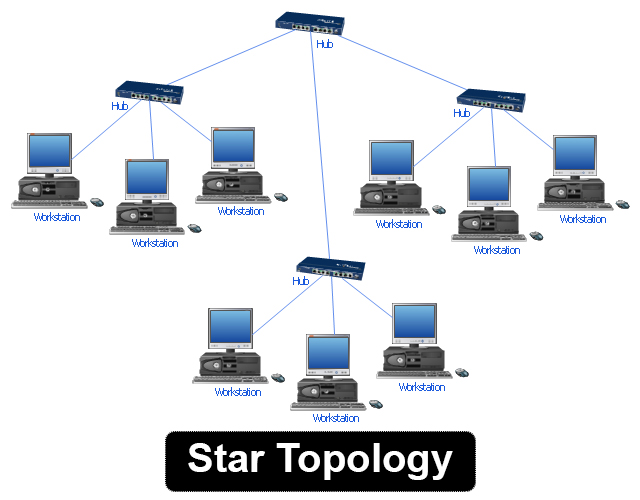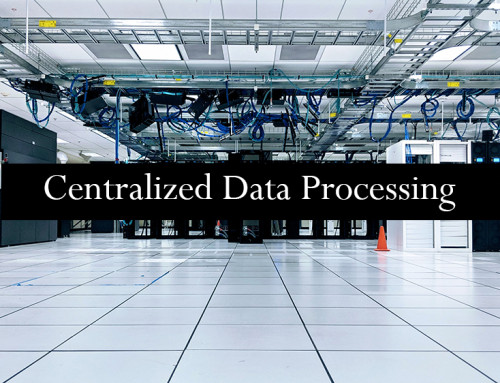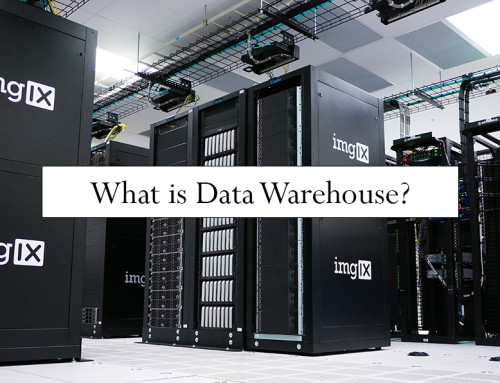Definition of star topology
A type of topology in which computers or devices are directly connected to the central hub. The devices which are connected be either a laptop, workstation, server, host, tablet, smartphone or printer.
The central hub can be either of the hub, switch, router or a central computer.
In making a network in star topology twisted pair cable, fiber optics, RJ-45 or coaxial cable is used depending upon the type of network card used in the computer. Star topology is mostly used in a client-server network. Each device in the network has a dedicated point to point link to a central hub.

All the computers are connected in such a way that it looks like a star so it is known as a star topology. Direct traffic between devices is not allowed. If any node wants to send data to other node then that data goes from central hub to the destination node. It is the most common network topology used. Hub also acts as a repeater to flow data to the destination.
If the hub is used as a central part of the network then it receives a message from any computer and then broadcast the message to all the computers. The message contains the mac address of the computer to which the data should be sent. So when the hub broadcast the message then if the mac address matches a computer in the network then that computer will receive the data.
If the switch is used as a central device then in the case of switch it stores all the mac addresses of the computers connected. So switch not broadcast the message to all the computers as it already knows mac addresses of computers connected to the switch. Data is sent to the destination computer if mac address of that computer matches from the switch.
Some features of the hub in star network are:-
- Hub can work with different cable types
- Every host is connected to the hub
- Hub also acts as a repeater to flow data to the destination
- Hub can also act as a central booster
- Hub can communicate with other hubs also
Some pros and cons of star topology are explained below:-
Advantages of star topology
Some features of star topology are:-
Robust:
Star network is very sensitive in error detection. It is easy to detect the error in the network. Any computer connected to the network has a point-to-point connection to the central hub so error detection is fast. It is also easy to install and reconfigure the network.
No data collision:
As data is transferred through the hub so there is no data collision in the network. In the case of ring topology, the data travels from one computer to another to reach the destination. In a bus topology, one computer can send data at a time. But in star topology data travels from multiple computers at a time.
Ideal for the large network:
As data is transferred at a high rate and without any data collision so it is ideal for making a large network. Multiple hubs can be connected to make the large network.
Reliable:
If any computer disconnects from the star network due to cable problem or software crashes then other computers in the network will not be affected.
Adding/removing nodes:
Any new node can be added to the network easily. The computer or workstation can be removed from the network without disturbing network connection. To connect a new node only one port is required to make a connection in the star network. For attaching a new device to the network one point to point cable is required from the device to the hub.
Fast in nature:
Star topology network is fast. The data transfer rate from one node to other is fast. The central hub acts as a signal booster and repeater also that makes the network fast.
Maintenance:
If any node faces the problem then the attached cable and port is checked and it is not required to check all computers. Star network is also simple and easy to troubleshoot. The security in the network is also high and data loss of any computer not occurs.
Good for businesses:
If you run a business then making a star topology network is a good choice. Star network can also be wireless where all the devices connect to the central hub wirelessly. You only need login information to connect to the network wirelessly.
Disadvantages of star topology
Some drawbacks of start topology are:-
Expensive:
If you compare star network with bus topology and ring topology then more cables are required in the case of star network topology so it is expensive. The cost of the hub, switch or router is also involved in making the network.
Performance:
The performance of the network depends upon the quality of the hub. If the hub is good for handling large traffic then it’s better else the network becomes slow on adding new devices. The performance of star topology depends upon how many devices are connected to the central hub
Network problem:
If the hub stops working then the whole network stops and connection among computers and devices no more works.
Hubs lacking ports:
Some hubs lack physical ports. So there is only one option to connect wirelessly through Wi-Fi or a mobile network.
Examples of star topology
- Client-server network
- Ethernet network
- Home network




